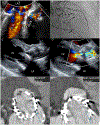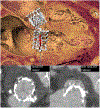Predicting Left Ventricular Outflow Tract Obstruction Despite Anterior Mitral Leaflet Resection: The "Skirt NeoLVOT"
- PMID: 29778867
- PMCID: PMC6531676
- DOI: 10.1016/j.jcmg.2018.04.005
Predicting Left Ventricular Outflow Tract Obstruction Despite Anterior Mitral Leaflet Resection: The "Skirt NeoLVOT"
Keywords: CT; complications; left ventricular outflow tract obstruction; mitral annular calcification; neo-LVOT; planning; transcatheter mitral valve replacement; transcoronary alcohol septal ablation; valve-in-MAC; valve-in-ring.
Figures






References
-
- Blanke P, Naoum C, Dvir D et al. Predicting LVOT Obstruction in Transcatheter Mitral Valve Implantation: Concept of the Neo-LVOT. JACC Cardiovasc Imaging 2016:10.1016/j.jcmg.2016.01.005. - PubMed
Publication types
MeSH terms
Grants and funding
LinkOut - more resources
Full Text Sources
Other Literature Sources

